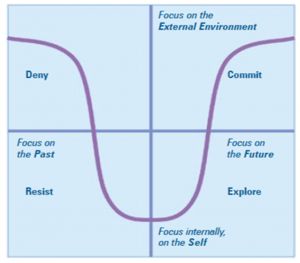Wednesday May 10 2017
“If you want to make enemies, try to change something” Woodrow Wilson
Why is it that we, as human beings, often dislike change? Clearly, the uncertainty that change brings with it is disconcerting and there is an accompanied feeling of a loss of control. In a business context, change often makes us question whether we have the skills required to perform in the new environment and WIIFM (what’s in it for me?). Whilst we obviously need to intellectually rationalize the change to accept it, it is evident that people do not and will not change unless they are emotionally invested as well. This, to me, is the “human side” of change – and studies have shown that one of the significant reasons a change process fails is because the organization has either ignored, or at best, paid little attention to, addressing the human side of change.

Change is hard and change is personal – this was first studied in the 1960s by a Swiss psychiatrist, Dr Elisabeth Kübler-Ross, when observing terminally ill patients go through different and distinct stages of grief before they accepted their condition. This study has been adapted to a business context as well, and specifically deals with the emotions employees go through during a change process. This is often represented in what is known as a Change Grid or a Change Curve. There are several representations of this, however, I find the one developed by Cynthia Scott and Dennis Jaffe very compelling:
So, let’s have a look at these phases of the change grid in a bit more detail and also try and understand how an organization could move employees along the curve. In each of these phases, I have tried to give an example of how management could address the intellectual and the emotional concern – remember, you need both for change!
Phase 1: Deny
“This is not happening to me”, “If I do nothing about this, it will go away”, “This is just another management fad which will not last” – any of these indicate employees in denial. I have also come across employees who do not necessarily express themselves, but continue working as if nothing has changed! So how could managers move along people in denial?
Phase 2: Resist
In this phase, employees focus on the past. “The old way was better”, “This will never work” are often the sentiments that you are faced with. This is different from Denial – here, the employee has understood that the change is on its way, but is determined to find every reason in the book to tell you why it will not work.
Phase 3: Explore
By now, you’re getting somewhere! At this stage, you will often find an employee introspecting – how will they cope with this change, how can they contribute to the process? The focus moves from the past to oneself. How will this change (which is now seen as being inevitable) affect the employee?
Phases 2 & 3 are very critical – this is the neutral zone and you will often see employees swinging between these phases. Supporting and motivating them is essential to see them through to Commitment.
Phase 4: Commit
By now, the employee does not feel the process is a new one. The changed process is the “new normal”. However, even when employees are committed to the change, they could slip back without the appropriate emotional support. Employees who have been through the journey have fought a lot of inner demons and have managed to make it through – so rewarding them is a great way to recognize their effort. I have found that appointing “ambassadors for change” resonates very well too. Not only does this recognize their efforts, but it enhances their stature among their peers which can be a very effective reward – and aspirational for other employees.
There is evidence to suggest that everybody goes through these phases when faced with change. Depending on their attitude to change, some may fly through the Denial and Resistance phases or they could spend a long time between the Resistance and Exploration phases. Although this may be a simplistic model to predict a more complex behaviour, it is, nonetheless, useful for managers to use as a tool and to keep in mind that the acceptance of change requires both, an intellectual and an emotional response.
“I’ve learned that people will forget what you said, people will forget what you did, but people will never forget how you made them feel.” Maya Angelou